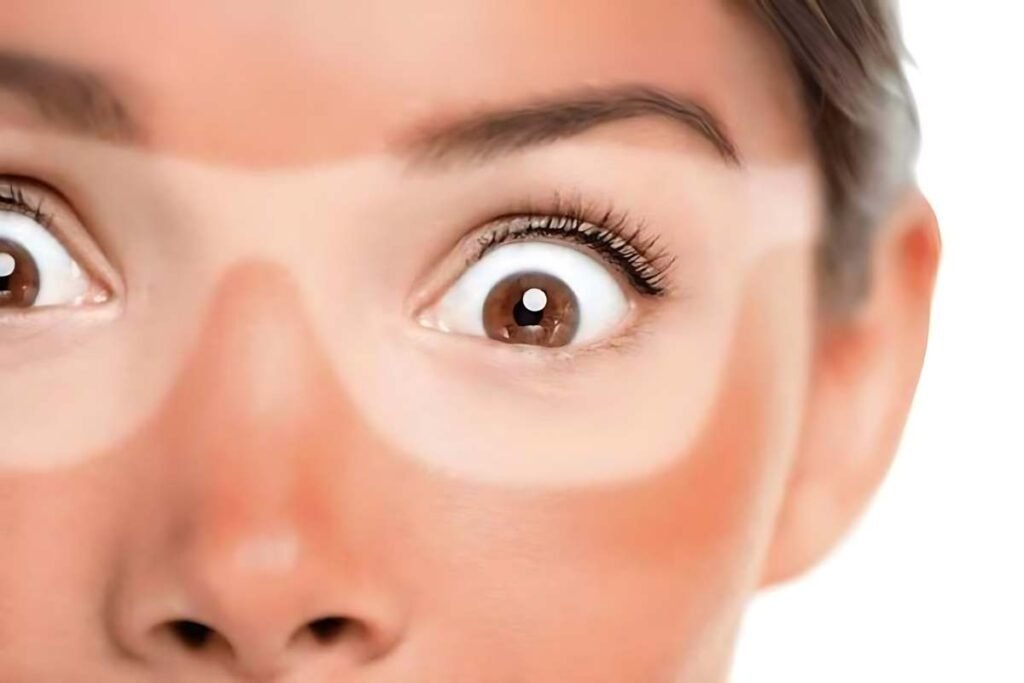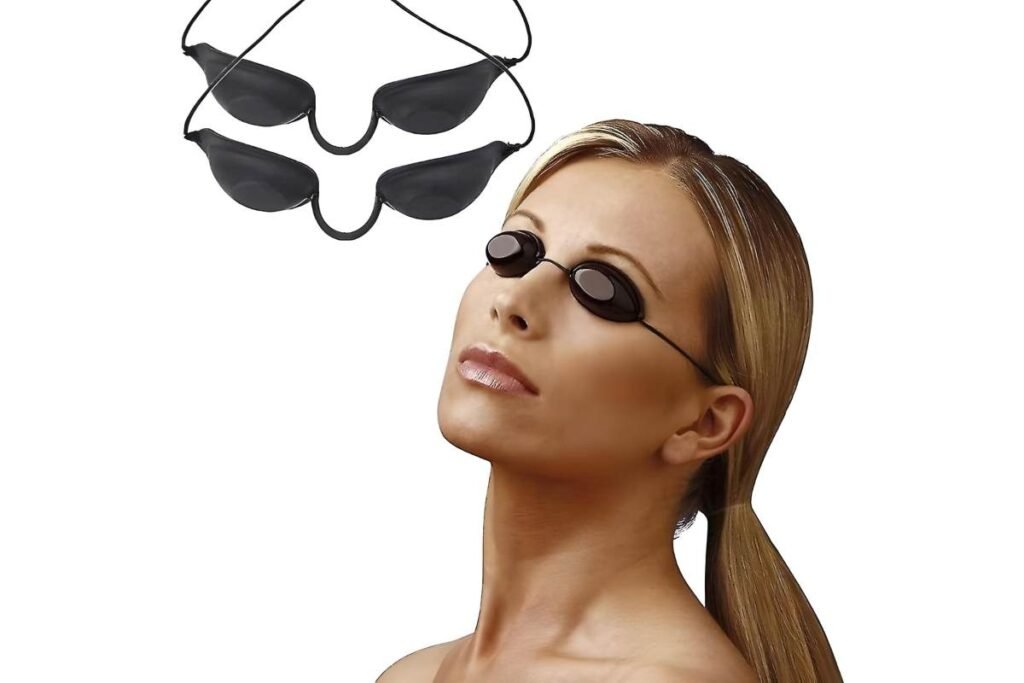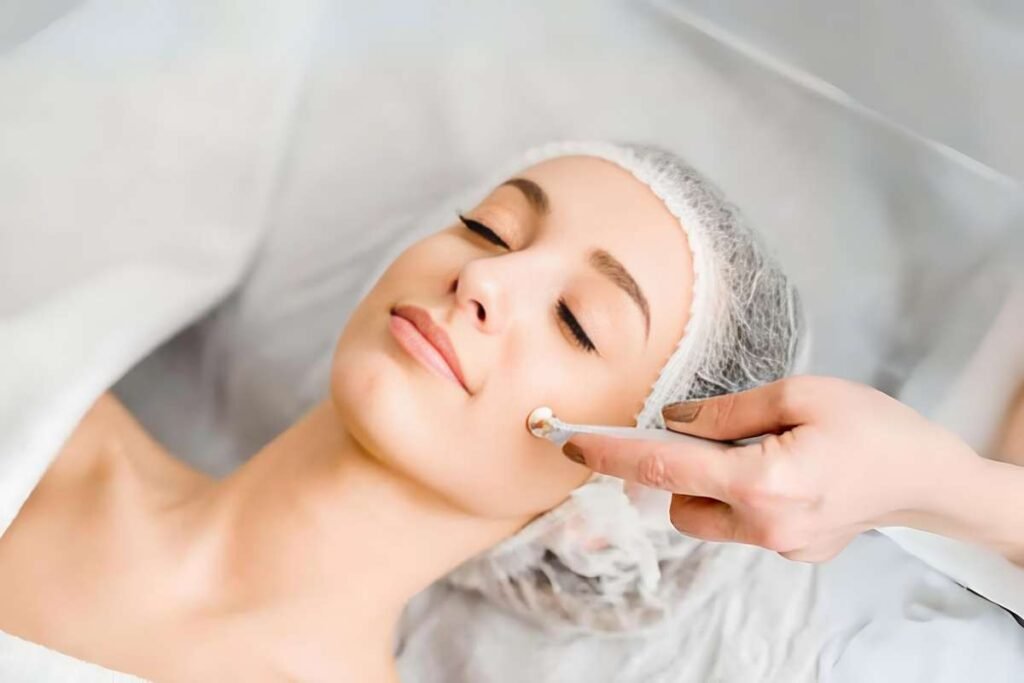
Table of Contents
Introduction
In recent years, a curious phenomenon has been gaining attention among eyeglass wearers – the infamous “glasses tan.”
While sunglasses are often associated with protecting the eyes from harmful UV rays, regular eyeglasses can inadvertently lead to uneven tanning or sunburn-like marks on the face.
In this article, we delve into the causes, effects, prevention, and remedies for this peculiar issue known as glasses tan.
Understanding Glasses Tan

What is Glasses Tan?
Glasses tan is a unique and often unintended effect where uneven tanning or sunburn-like marks appear on the face, specifically in the areas obstructed by the frames of eyeglasses.
This phenomenon is a result of prolonged exposure to the sun, where the skin that is covered by the eyeglass frames typically around the eyes and the bridge of the nose – remains lighter, while the rest of the face receives more sunlight and becomes darker.
It’s a clear indication of the contrasting effects of sun exposure on skin areas shielded by objects versus those directly exposed.
This situation is most common during the sunny seasons or among individuals who spend a significant amount of time outdoors without adequate sun protection for their skin, leading to a distinctive pattern that highlights the shape of the eyeglass frames.
Causes of Glasses Tan
The primary cause of what is commonly known as a glasses tan arises when the frames of eyeglasses act as a barrier to sunlight.
This obstruction creates a noticeable contrast between the skin areas covered by the glasses and those left exposed to direct sunlight, leading to uneven tanning or even sunburns in more severe cases.
The severity and pattern of a glasses tan can be influenced by several factors including the design and thickness of the eyeglass frames, the tint of the lenses which might block varying degrees of sunlight, and the angle at which sunlight hits the face, which can vary based on the time of day and activities being performed outdoors.
This phenomenon highlights the unique interaction between eyewear and natural light, emphasizing the importance of considering protective measures for those spending significant time in the sun.
Effects of Glasses Tan

Skin Damage
Prolonged exposure to sunlight, particularly without sufficient protection, can lead to a range of skin damage. One common but often overlooked issue is a glasses tan, which results from the UV rays hitting the areas around your eyewear, leading to uneven pigmentation.
This can not only cause an irregular skin tone but also contribute to premature aging, manifesting as wrinkles and loss of skin elasticity.
In more severe cases, the cumulative effects of sun damage can significantly increase the risk of developing skin cancer, highlighting the critical need for protective measures such as sunscreen and wearing hats.
Cosmetic Concerns
Beyond the health implications, the phenomenon of glasses tan can lead to significant cosmetic concerns for individuals.
The presence of uneven tan lines, especially around the eyes where glasses typically sit, can significantly detract from one’s overall appearance.
This issue becomes particularly pronounced during the warmer months. During this time, people tend to wear lighter and more revealing clothing, meaning more skin is exposed to the sun’s rays.
Consequently, the contrast between tanned skin and the lighter patches left by glasses frames can be more noticeable, potentially leading to feelings of self-consciousness or dissatisfaction with one’s appearance.
Prevention of Glasses Tan

Use of Sunscreen
Applying a broad-spectrum sunscreen with a high SPF (Sun Protection Factor) to the exposed areas of the face is a crucial step in preventing the formation of glasses tan.
It’s important to select a sunscreen that offers protection against both UVA and UVB rays. Ensure that the sunscreen is applied generously and evenly across all exposed areas, not forgetting the delicate skin around the eyes and the bridge of the nose where the glasses rest.
Reapplication is key for maintaining protection throughout the day, especially after activities like swimming or sweating, which can remove the sunscreen.
Following these steps diligently can significantly reduce the risk of uneven tanning and skin damage.
Choosing Eyeglass Frames Wisely
Choosing eyeglass frames that feature thinner or lighter designs can significantly minimize the obstruction caused by sunlight on your face, thereby reducing the chances of developing a noticeable glasses tan.
This is particularly beneficial during the sunny months when exposure to sunlight is at its peak. For those especially concerned about tan lines, opting for frameless or rimless glasses can be an excellent alternative.
These types of glasses offer minimal coverage, ensuring an even tan across the face while still providing the necessary vision correction.
Wearing Hats or Visors
Supplementing eyeglasses with hats or visors not only elevates your style but also offers significant additional protection from the harmful rays of the sun, helping to mitigate the effects of glasses tan.
By choosing wide-brimmed hats or visors, you can effectively shade not just your face but also your neck and eyes, significantly reducing your overall sun exposure.
This simple yet effective method can greatly enhance your sun protection routine, providing an extra layer of defense against UV radiation while ensuring that you remain comfortable and stylish.
Utilizing Polarized Lenses
Polarized lenses are designed to significantly improve visual clarity by enhancing contrast and reducing glare, which is particularly beneficial in bright sunlight.
Besides their ability to enhance visuals, these lenses play a crucial role in blocking harmful ultraviolet (UV) rays from the sun, effectively protecting the eyes from potential damage.
When choosing eyeglass lenses, it’s worthwhile to consider the advantages of polarized options. Not only do they contribute to better vision and eye health, but they also minimize the risk of developing an uneven tan around the eyes, commonly referred to as glasses tan.
Opting for polarized lenses can be a smart choice for those looking to combine style, comfort, and protection in their eyewear.
Seeking Shade
When spending extended periods outside, it’s crucial to seek shade whenever possible to minimize direct exposure to the sun’s harmful rays.
This strategy is especially beneficial during peak UV hours, which are typically between 10 a.m. and 4 p.m. Seeking shade under trees, umbrellas, or canopies can significantly reduce the risk of sunburn and heat-related illnesses.
Additionally, planning outdoor activities for earlier in the morning or later in the afternoon can also help avoid the most intense UV radiation.
Remember, protecting yourself from the sun is important for preventing long-term skin damage and maintaining overall health.
Remedies for Glasses Tan

Hydration and Moisturization
To mitigate the impact of a Glasses tan, it’s crucial to ensure that your skin remains well-hydrated by consuming ample amounts of water throughout the day.
This not only helps in maintaining the skin’s elasticity but also aids in its recovery process from any form of sun damage. Additionally, applying a good quality moisturizer to the affected areas on a regular basis can further enhance the skin’s ability to rejuvenate.
Moisturized skin is less prone to peeling and can heal more efficiently, thus helping to even out any tan lines caused by wearing glasses.
Remember, hydrated and moisturized skin is key to a healthy and even complexion, especially in recovering from sun exposure.
Cool Compresses
To alleviate the irritation and decrease the inflammation that results from a glasses tan, one effective method is applying cool compresses to the affected skin areas.
You can achieve this by using a clean cloth that has been thoroughly soaked in cold water or enriched with aloe vera gel, which provides additional soothing properties.
Gently pressing this compress against your skin not only helps in calming the irritation but also significantly reduces the inflammation, offering a sense of relief.
Over-the-Counter Remedies
To alleviate discomfort and promote healing, you can use over-the-counter creams or gels that contain soothing ingredients like aloe vera, vitamin E, or hydrocortisone.
These ingredients have properties that can calm skin irritation and reduce inflammation. When using these products, it’s crucial to follow the product instructions carefully to ensure proper application and dosage.
Additionally, pay close attention to how your skin reacts to these treatments. If you experience any adverse reactions, such as increased redness, itching, or swelling, it’s important to discontinue use immediately and consult a healthcare professional if necessary.
Professional Treatments

For severe cases of glasses tan or persistent skin discoloration that do not respond to conventional methods, it’s advisable to consult a dermatologist to explore professional treatment options.
These medical professionals can offer a tailored approach based on the individual’s skin type and the severity of the discoloration.
Procedures such as chemical peels, which remove the outer layer of damaged skin, laser therapy that targets and breaks down the pigmentation, or microdermabrasion, a less invasive treatment that exfoliates the skin to improve tone and texture, may be recommended.
These treatments can effectively address sun damage, reduce the appearance of glasses tan, and restore the skin’s health, leaving it looking more even and rejuvenated.
Conclusion
Glasses tan is a unique and increasingly recognized issue among eyeglass wearers, resulting from prolonged sun exposure and the obstruction caused by eyewear frames.
While often considered a cosmetic concern, glasses tan can also signify potential skin damage and increase the risk of long-term issues such as premature aging and skin cancer.
However, with proper understanding and preventive measures such as sunscreen application, choosing suitable eyeglass frames, seeking shade, and utilizing remedies like hydration and professional treatments when necessary, individuals can effectively manage and mitigate the effects of glasses tan.
By prioritizing sun protection and skin health, eyeglass wearers can enjoy the outdoors safely and maintain a radiant, even complexion.
FAQs
What exactly causes glasses tan?
Glasses tan happens when eyeglass frames block sunlight, causing uneven tanning or sunburn marks on the face. This is due to long sun exposure, where skin under the frames stays lighter than the exposed areas.
Can wearing sunscreen prevent glasses tan?
Yes, using high SPF sunscreen on exposed facial areas, such as around the eyes and nose bridge, can greatly lower the risk of getting a glasses tan. Reapplying sunscreen, especially after swimming or sweating, is key to keeping protection all day.
Are certain types of eyeglass frames more likely to cause glasses tan?
Thicker, darker frames can deepen a glasses tan by blocking more sunlight. Opting for thinner, lighter, or frameless glasses can reduce this by allowing more uniform sun exposure on the face.
How can polarized lenses help prevent glasses tan?
Polarized lenses enhance visual clarity, reduce glare, and block harmful UV rays. Opting for polarized eyeglass lenses helps protect eyes and prevents the common issue of an uneven tan around the eyes, known as glasses tan.
Is seeking shade an effective way to prevent glasses tan?
Yes, seeking shade, especially during peak UV hours from 10 a.m. to 4 p.m., can reduce the risk of a glasses tan. Shade serves as a barrier to direct sunlight, lessening the contrast between areas covered by eyeglass frames and those exposed.
How can hydration and moisturization help alleviate glasses tan?
Drinking plenty of water and regular moisturizer use can help skin recover from sun damage. Hydrated skin is less likely to peel and heals faster, evening out tan lines from glasses.
Are over-the-counter remedies effective in treating glasses tan?
Over-the-counter creams or gels with aloe vera, vitamin E, or hydrocortisone can ease discomfort and help heal glasses tan. It’s important to follow directions and stop use if reactions occur.
When should I consider seeking professional treatment for glasses tan?
If a glasses tan persists or you’re worried about skin discoloration, seeing a dermatologist is wise. They can suggest treatments such as chemical peels, laser therapy, or microdermabrasion for severe tan or skin damage.



Leave a Reply